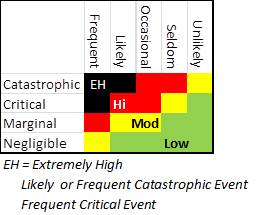FORSCOM Refers Extremely High Risk to Chaplains
The US Army Forces Command (FORSCOM) has rolled out a new mandatory risk assessment that identifies chaplains as the primary referral for the most extreme risk cases. The assessment is a counseling form between a soldier and his or her leader with specific actions to take for high risk responses. This use of chaplains for mitigation of extreme risk lays bare the myth that chaplains exist only for religious support activities and that atheists would not need their advocacy. This assignment also shows how reliance on chaplains is exceeding chaplain training and credentials.
Chaplains are trained and commonly used as informal counselors, but using them in “Extremely High Risk” situations sets soldiers and chaplains up for failure. Army Field Manual 5-19 indicates that Extremely High Risk refers to “likely” occurrence of events such as “significant collateral damage,” “extensive major damage,” “permanent total disability,” or worse. These kinds of controls should be of direct command interest, without delegation, especially to chaplains.
A licensed psychotherapy supervisor and former Army chaplain offered the following insight:
“I would also want some sort of written assurance from the chaplain that the chaplain was comfortable personally, professionally, and theologically using the test results, interviewing the soldier and making mental health referrals — as some faith groups deny or minimize the existence of poor mental health. [C]haplains do not have adequate counselor education, supervised training, or experience beyond basic screening and referral.”
Chaplains have limited counseling training, no required professional counseling credentials, and no association with other assessed areas like motor vehicle or handgun licensing. In addition, chaplains continue to reject training on the nontheist perspective, so they are likely to cause harm if atheists or humanists are referred to their care. This FORSCOM tool should be amended to refer military personnel to trained counselors or mental health professionals in the event of a high-risk mental issues.
To the credit of FORSCOM, the assessment itself recommends action specific to each risk area, identifying medical personnel, command representatives, or licensing options as appropriate. However, chaplain referrals are recommended for situations ranging from substance abuse to poor performance to being under age 21. This over-referral to chaplains is inappropriate and confers too much responsibility on chaplains for a counseling role that exceeds the basic informal counseling they are trained and commissioned to provide.
The Military Association of Atheists & Freethinkers obtained the risk document from members concerned that the program would not properly mitigate severe risk factors. The assessment rightfully excludes “spirituality” as a risk factor, avoiding the problems created by the Comprehensive Soldier Fitness program. However, the assignment of a chaplain to mitigate general risk factors, especially at the severe level, exceeds the chaplain corps counseling mandate and should be replaced with a more appropriate command representative. Currently the form recommends “Platoon-level” and “Company-level” for lower categories, and “Chaplain” at the battalion level. (Note that battalion staff is the lowest level of assignment for chaplains.)
It would be easy to recommend a general referral to “Battalion-level” to fit with the other areas, but this assignment would almost certainly fall to the chaplain to resolve. The core issue lies with the absence of a certified counselor and the over-subscription of chaplain counseling for all manner of maladies. In addition, chaplains are untrained in the perspectives, beliefs, and communities of the atheists and humanists in their unit, making them unqualified to provide proper referrals and support for those soldiers. Requiring chaplains to be certified counselors (not simply faith-based pastoral care professionals) will increase the qualifications of chaplains in these secular counseling roles. In the interim, the commander personally should have direct responsibility to reduce or mitigate the risk factors associated with any “Extremely High Risk.”

